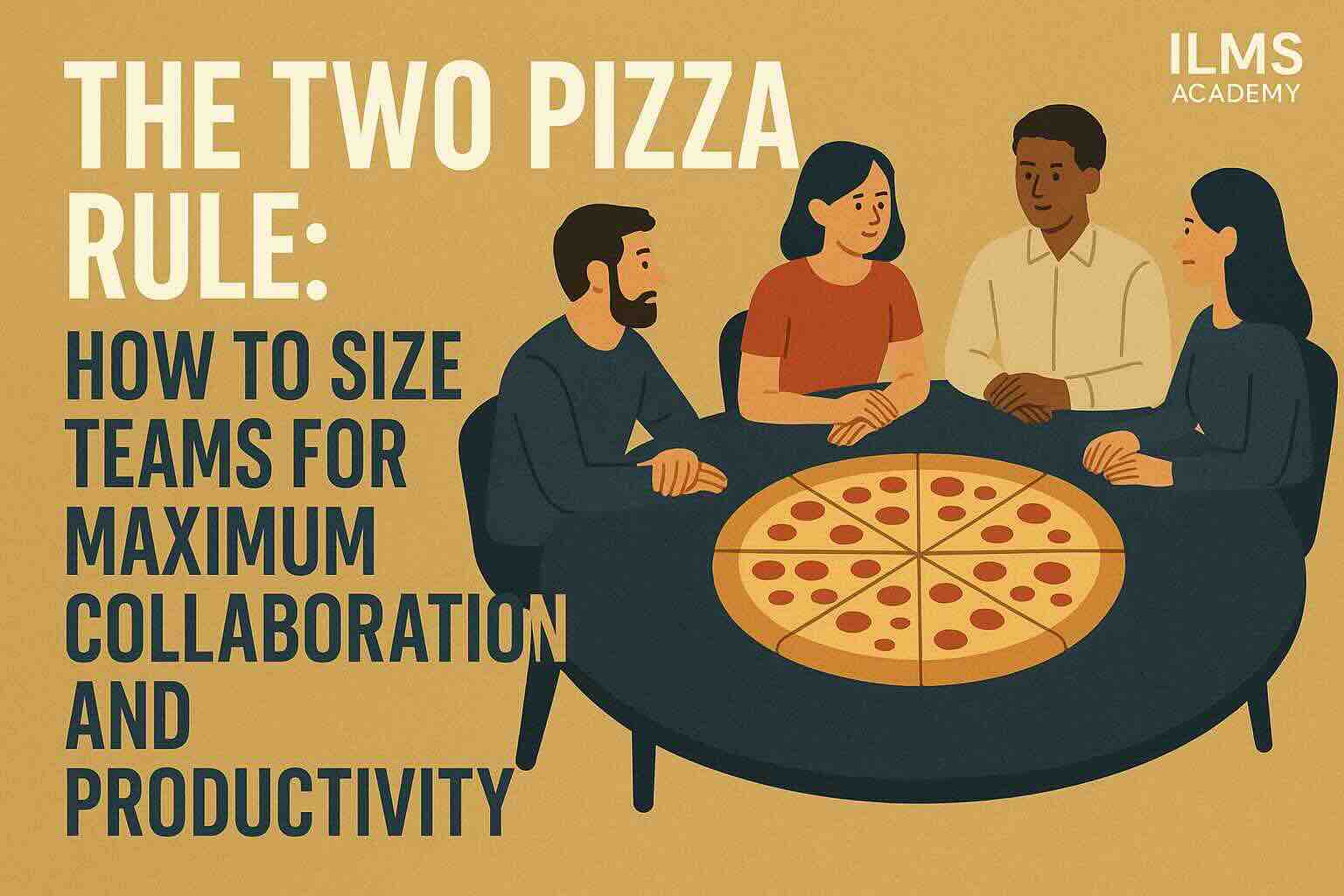The Two Pizza Rule: How to Size Teams for Maximum Collaboration and Productivity

Table of Contents
- The Two Pizza Rule
- The Reasoning behind the Two Pizza Rule
- Team Size, Productivity, and Collaboration
- Examples of the Two Pizza Rule in Practice
- Strategies for Implementing the Two Pizza Rule
- Corporate Case Study: Amazon’s Use of the Two Pizza Rule
-
Conclusion: Optimizing Team Size for Sustainable Success
The Two Pizza Rule: How to Size Teams for Maximum Collaboration and Productivity
The “Two Pizza Rule,” attributed to Amazon founder Jeff Bezos, states that teams must be small enough to be fed by two pizzas. This apparently obvious rule distills a deep observation of team behavior: smaller groups engender improved communication, cooperation, and efficiency. The principle focuses on restricting group size to ensure that each member can make meaningful contributions and become an active participant, avoiding effort dilution and the coordination issues that often haunt large groups.
This rule is not a fanciful proposal; it is an expression of profound insight into human interaction and the constraints of mass collaboration. By following the Two Pizza Rule, organizations can establish settings in which teams are nimble, responsive, and able to produce outstanding results.
The Reasoning Behind the Two Pizza Rule
There are a number of reasons why small teams are so effective:
-
Improved Communication:
- Small teams allow more open and more frequent communication, with less chance for misunderstandings and information silos.
- Each member stands a better chance of being heard and understood.
-
Improved Collaboration:
- When teams are smaller, members tend to work better together, trading ideas and brainstorming to fix problems.
- A stronger feeling of shared ownership and responsibility develops.
-
Better Decision-Making:
- Teams of a smaller size are able to decide more rapidly and effectively, as there are fewer perspectives to blend.
- Decisions tend to be more flexible and more responsive to change.
-
Increased Accountability:
- In smaller teams, individual contributions are more apparent, resulting in higher accountability and stronger ownership.
- Social loafing is reduced.
-
Less Coordination Overhead:
- More complex coordination mechanisms are needed in larger teams, resulting in higher overhead and lower efficiency.
- Smaller teams function with higher agility and flexibility.
</style>
Team Size, Productivity, and Collaboration
The productivity and collaboration of a team depend directly on its size:
-
Diminishing Returns:
- With an increase in the size of the team, the marginal value of each new member reduces at some point, ultimately resulting in diminishing returns.
- There is an exponential rise in coordination cost.
-
Breakdown in Communication:
- Larger teams are more likely to experience communication breakdowns, resulting in misunderstandings, delays, and mistakes.
- Information silos may form.
-
Decision-Making Delays:
- Large teams tend to take a long time to make decisions and make them efficiently, as there are too many perspectives to balance.
- Groupthink may happen.
-
Decreased Accountability:
- In bigger teams, individual efforts are less apparent, resulting in lower accountability and more social loafing.
- People can get lost in the crowd.
Examples of the Two Pizza Rule in Practice
-
Software Development Teams:
- Agile development teams usually follow the Two Pizza Rule by forming small, cross-functional teams that work autonomously and produce results swiftly.
-
Project Management Teams:
- Project management teams on large-scale projects can leverage the Two Pizza Rule by subdividing the project into smaller tasks and delegating them to small teams.
-
Marketing Teams:
- Marketing teams managing campaigns can increase their productivity and creativity by establishing small teams specialized in certain campaign areas, including social media, content, or advertising.
-
Research and Development Teams:
- R&D teams conducting research on new technologies can maximize their innovation and collaboration by establishing small teams specializing in certain research areas.
-
Start-up Companies:
- Start-up businesses, with the requirement of rapidity and agility, commonly adopt the Two Pizza Rule so that rapid iterations are possible and rapid decision-making is facilitated.
</style>
- Certificate Course in Labour Laws
- Certificate Course in Drafting of Pleadings
- Certificate Programme in Train The Trainer (TTT) PoSH
- Certificate course in Contract Drafting
- Certificate Course in HRM (Human Resource Management)
- Online Certificate course on RTI (English/हिंदी)
- Guide to setup Startup in India
- HR Analytics Certification Course
Strategies for Implementing the Two Pizza Rule
There are various strategies that organizations may use to effectively implement the Two Pizza Rule:
-
Split Large Projects:
- Split large projects into smaller task sizes and assign them to tiny teams.
-
Build Cross-Functional Teams:
- Build teams with members possessing different skills and expertise to provide coverage for all areas of the project.
-
Empower Teams:
- Grant teams the power to make decisions and control their own work.
-
Establish a Culture of Collaboration:
- Provide open communication, sharing of ideas, and teamwork.
-
Continuously Assess Team Size:
- Regularly review team size to make sure that it is optimal for productivity and collaboration.
-
Use Agile Methodologies:
- Small teams are well suited for Agile methodologies.
Corporate Case Study: Amazon’s Use of the Two Pizza Rule
Amazon’s practice of the Two Pizza Rule is a foundation of its organizational culture. The company trusts small, independent teams to innovate and achieve results. These teams, commonly called “Two-Pizza Teams,” are assigned a particular product or service and have the autonomy to make decisions and control their own work.
This method has allowed Amazon to stay agile and innovative despite its enormous size. By adopting a structure of small, empowered teams, Amazon has created a culture in which employees are energized, engaged, and able to deliver outstanding results. Amazon’s success is a testament to the strength of the Two Pizza Rule.
Conclusion: Optimizing Team Size for Sustainable Success
The Two Pizza Rule, though a seemingly straightforward rule, captures a deep insight into the dynamics that drive successful teamwork. It is a strong reminder that size does matter in creating collaboration, communication, and productivity. By promoting teams small enough to be fed with two pizzas, this principle underscores the need to restrict team size so that each member can contribute actively, participate, and feel a sense of ownership.
This is not just about cost savings or convenience; it’s about building a culture where human connection flourishes. Smaller teams allow for more open and regular communication, minimizing the potential for misunderstandings and information silos. They also create a higher sense of shared responsibility, which translates into greater accountability and a deeper commitment to shared objectives.
The effect of team size on productivity is undisputable. The marginal contribution of each new member decreases as the teams expand, while coordination costs escalate exponentially. Communication failures, delayed decisions, and less accountability become more common, slowing down the team’s efficiency and effectiveness.
- Certificate Course in Labour Laws
- Certificate Course in Drafting of Pleadings
- Certificate Programme in Train The Trainer (TTT) PoSH
- Certificate course in Contract Drafting
- Certificate Course in HRM (Human Resource Management)
- Online Certificate course on RTI (English/हिंदी)
- Guide to setup Startup in India
- HR Analytics Certification Course
Applying the Two Pizza Rule involves a strategic and intentional process. Organizations need to divide big projects into smaller, manageable tasks and allocate them to cross-functional teams with varied skills and expertise. Giving these teams autonomy and creating a culture of collaboration are critical to unlocking their full potential. Periodic review of team size and embracing agile methodologies can also help increase their effectiveness.
Amazon’s effective application of the Two Pizza Rule is a powerful demonstration of its effectiveness. By organizing into small, independent groups, Amazon has been able to retain its nimbleness and creativity in spite of its enormous size. This has allowed the company to quickly build and release new products and services, beating the competition and consistently achieving outstanding results.
In short, the Two Pizza Rule is not merely a team size guideline; it’s an ideology that favours human engagement, collaboration, and empowerment. When organizations adopt this principle, they can create high-performing, agile teams that can facilitate innovation, address complicated issues, and attain lasting success. As the business world evolves further, quick adaptability and responsiveness become more important than ever. The Two Pizza Rule is an excellent guideline to follow in forming teams that not only deliver work but are resilient and adaptable enough to be long-term successes within an organization. It is a team-building guide for forming groups that are far more than simply the sum of their parts.
- Certificate Course in Labour Laws
- Certificate Course in Drafting of Pleadings
- Certificate Programme in Train The Trainer (TTT) PoSH
- Certificate course in Contract Drafting
- Certificate Course in HRM (Human Resource Management)
- Online Certificate course on RTI (English/हिंदी)
- Guide to setup Startup in India
- HR Analytics Certification Course
